I like the suspence - you didn't tell us hoh the Venetian war finished. Let me guess, you take Crete and one (or two - HRE penalties?!) tierra firma provs. Agains France you can play defencively i bielieve.
Repubblica di Genova/Republic of Genoa - a MMU Story
- Thread starter axzhang
- Start date
-
We have updated our Community Code of Conduct. Please read through the new rules for the forum that are an integral part of Paradox Interactive’s User Agreement.
You are using an out of date browser. It may not display this or other websites correctly.
You should upgrade or use an alternative browser.
You should upgrade or use an alternative browser.
__________________________________________________
Chapter V. The King, the Doge,
and the Pope
1486-1508, the following chronicle
the conclusion of the Venetian war,
consolidation of Lombardia,
and developments in Iberia
__________________________________________________
Foreword
Chapter V. The King, the Doge,
and the Pope
1486-1508, the following chronicle
the conclusion of the Venetian war,
consolidation of Lombardia,
and developments in Iberia
__________________________________________________
Foreword
With Pietro di Campofregoso's passing in 1487, the reigns of the Republic passed from the hands of the Fregoso family to the Busca family. Pantaleone Grimaldi di Busca, already in his late sixties, was a lawyer and well connected. Upon election, he inherited the Republic's continued war against Venice.
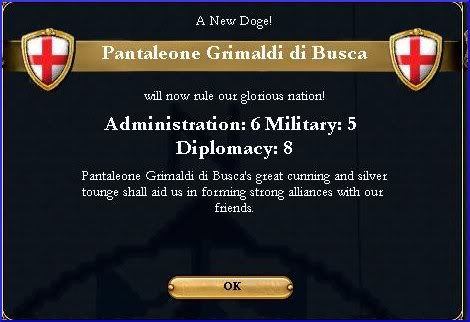
The Busca family takes the helm
__________________________________________________
The Franco-Italian Adventures

On December 1487, the Imperial League of Austria, Hungary, and the Papacy agreed on peace with the Republic of Venice. In a humiliating ceremony in the courtyard of St. Peter's in Rome, Simone Toscani, the Doge of Venice, was made to kneel for a full hour while the terms of peace and the list of Venice's transgressions were read out in full. A symbolic whip was then handed out by Pope Pius III himself (thankfully, the flogging of the Doge was omitted). Only after kissing Pius III's feet and absolution received were the doors of St Peter's opened and interdiction over Venezia lifted.
Meanwhile, the Republic of Genoa and other princes of Europe were not amused. Genoa continued to occupy the entirety of the Venetian countryside, while scribes scoured the libraries of the University of Padua and Florence researching legitimate claims Genoa could press on the provinces. At least the occupying force was benign – for the first time in three years the people of the Veneto and Friuli were able to rebuild their shattered homes, resow their barren fields, and sleep without being troubled by the trail of rapine pillage and blood left by marauding armies.
When Henri II de Valois heard of the withdrawal of the Hungarian and Austrian armies and the reconciliation between the Papacy and Venice, he was said to have flown into a murderous rage. Already incensed at the Pope's failure to invite France to the League that carved up Venice, Henri was further insulted by Pius III's promise of Brescia and Bergamo to the Duchy of Milan, a title that the Valois House has long coveted. Whereas the Pope had previously been the chief architect of Venice's humiliation, he was now suddenly her protector and salvation. That was too much to bear. France, in concert with her Italian ally, Frederico II Gonzaga of Modena, declares war on the Papal States.
As usual, Pius III fought against his temporal enemies with all the diplomatic, spiritual, and military power at his disposal. Though the Papacy's allies were reluctant to engage in open war with the House of Valois (Genoa dishonors alliance against France), Pius III struck a diplomatic coup'd-etat in the December of 1488. In a bull framed in language that would have made St Peter cover his ears in shame, Frederico II and the house of Gonzaga were excommunicated in the winter of that year.
Seizing the opportunity of spiritual isolation, the House of Sforza, doubtlessly through Papal manipulation, declares war on the Duchy of Modena the following year. However, the network of alliances that interwove Italy since the Guelph and Ghibbeline civil wars proved to be the House of Sforza's undoing. Savoy, Tuscany, and Urbino, traditional Ghibbeline allies, all come to the Duchy's rescue. The Genoese Republic, long wary of the House of Sforza's machinations and recalling the oppression Ligurians suffered under Milan's rule in the 1400s, leads the alliance of Ghibbelines against the Sforzas.
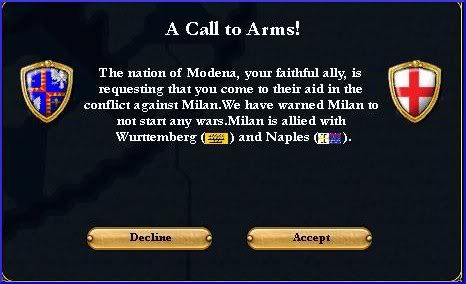
Warning issued, call to arms honored
Victory comes quickly – here the power of advancement in firearms comes to bear. Though the Milanese army was augmented by Swiss mercenaries bearing their traditional pikes, the outfitting of the first wheel-lock firearms to the Genoese and Savoyard armies proved far superior to the Milanese on the field. Whereas the Swiss mercenaries under Francesco II Sforza fought valiantly, they were routed by the organized barrage of fire from the new guns.
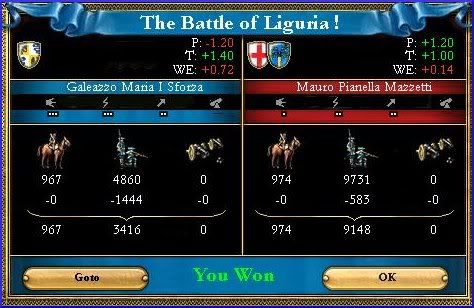
Milanese army routed under combined weight of other Italian states
In 1489, Milan became a protectorate under the Genoese Republic. The House of Sforza was allowed to keep its titles and claims – but a hefty share of Lombardia's tax revenue would forevermore flow into the Republic's treasury.
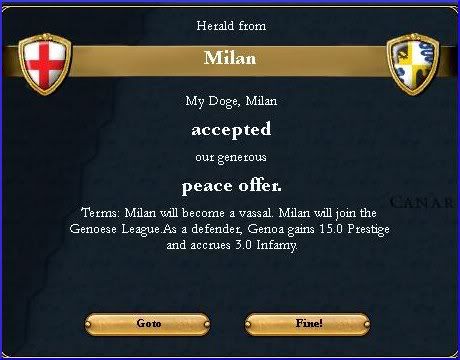
Formal vassalization of Duchy of Milan. Nary a word of protest from foreign courts
Meanwhile, Henri II de Valois' war against the Papal States was reaching its climax. Ragged, tired, and underpaid, the mercenaries under Papal control were no match for the French troops. On Easter Sunday at Romagna, French forces stormed and captured the papal forces stationed in the fortress. When news of the French victory arrived at Rome, Pius III was said to have fallen into a stupor, refusing to leave his chambers. Within a week, he was dead.
It was a ten days before the guardians of the conclave announced their choice for the next man to fill the vacant seat. Cardinal Giovanni de' Medici was their choice.

Pope Leo X, a scion of the powerful Medici family
A native of Florence and son of the influential Medici family, he was very much the antithesis of Pius. A man of peace – indeed within the curia he was mockingly known as “His Cautiousness” - he had no delusions about the capacity of the French Kingdom for war. Avignon was ceded to France, while Romagna would remain a “base of operations” for French forces until they could fully retreat from Italy proper (France annexes Romagna but returns it to the Pope after a year).
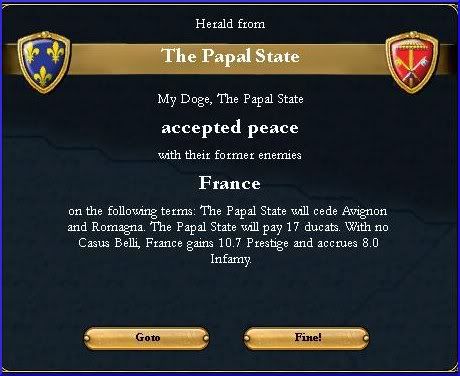
End of the French conflict with the Papacy
Grimaldi di Busca, unlike his predecessor Pietro di Campofregosso, was no visionary. He was by all accounts a practical man. With Genoa's quickness to defend France's chief Italian ally Modena in the Papal wars, relations normalized between the House of Anjou and House of Busca. In July 1490, a military alliance is secured.

Opportunism in allying with the powerful Valois House
Back to Venezia – the people of Veneto, long fed up of occupation by the House of Hapsburg one day and the House of Sforza the next, have grown accustomed to the peace and quiet of Genoese rule. In the period of 1496 – 1501, the provinces of Friuli, Treviso, Brescia, Verona, and finally Venice itself quietly transitioned to Genoese possession. The Republic of Venice was to survive for two more years in Istria before she drew her final breath – annexation by the House of Hapsburg.
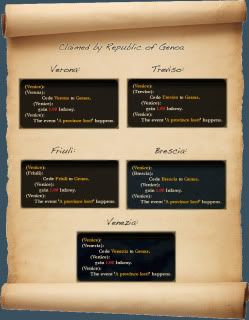
The following year, the Duchy of Milan accepted the annexation proposal set forth by the Republic's council. The brilliant diplomatic attache to the Republic, Luigi Veneroso, smoothed over the transition with the various courts of Europe. A most befitting end to the House of Sforza who once ruled over all of Lombardia and Liguria.
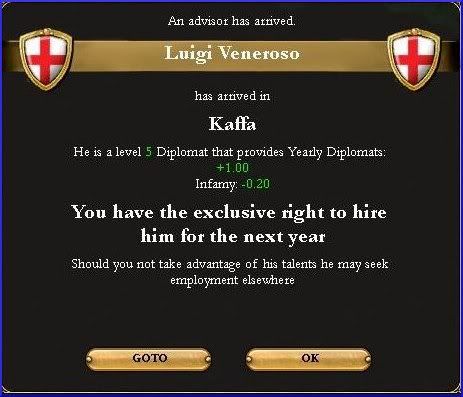
Luigi Veneroso helped quieten the protests from the Princes of Europe
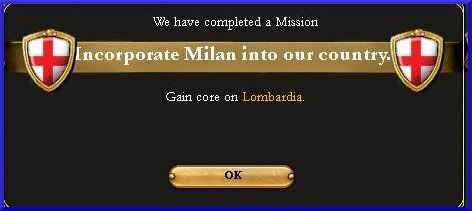
Lombardia and Parma formally annexed
__________________________________________________
Iberian Affairs
While the states of Italy slowly hobbles to recovery after years of privation and war, prosperity was on the horizon for the Atlantic-facing Iberians. On 12 October, 1492, it is said that the expedition under the auspices of the Castillian crown, headed by a Genoese man, landed in a distant port off the coast of India. Thus far, the voyages westward have barely recuperated the expenses incurred by the the Castillians – apart from a few savages taken back as novelty and slaves, there has been no sign of the riches of the Orient.
The Portuguese, on the other hand, have proven much more industrious in their eastward journey around the Cape of Storms (henceforth named the Cape of Good Hope). Under Vasco De Gama, they say a distant port off the coast of Calicut was seized by the expeditionary force. The uproarious acclaim of his return has travelled as far as Liguria, even though only a dozen of the original 40 sailors survived. The Portuguese have proven that their ships are capable – though just barely – of getting to India and back. The cache of peppers De Gama returned with paid for the expedition ten times over – a most worthwhile bargain for the lives of 30 men.

Vasco De Gama conquers Goa off the coast of Calicut and Malabar
Even though the first colonial ventures abroad to the Canary Islands was a complete success, resulting in the formal incorporation of the islands to provincial status under the Republic, the islands still lacks the infrastructure needed to serve as a base of operations for Genoa (Coring process begins).

Canaries is finally settled after years of restriction on growth
Without the visionary guidance of Pietro di Campofregosso, Genoa was slowly forgetting the dream of an Atlantic voyage that once consumed the Republic.

The Busca family takes the helm
__________________________________________________
The Franco-Italian Adventures

On December 1487, the Imperial League of Austria, Hungary, and the Papacy agreed on peace with the Republic of Venice. In a humiliating ceremony in the courtyard of St. Peter's in Rome, Simone Toscani, the Doge of Venice, was made to kneel for a full hour while the terms of peace and the list of Venice's transgressions were read out in full. A symbolic whip was then handed out by Pope Pius III himself (thankfully, the flogging of the Doge was omitted). Only after kissing Pius III's feet and absolution received were the doors of St Peter's opened and interdiction over Venezia lifted.
Meanwhile, the Republic of Genoa and other princes of Europe were not amused. Genoa continued to occupy the entirety of the Venetian countryside, while scribes scoured the libraries of the University of Padua and Florence researching legitimate claims Genoa could press on the provinces. At least the occupying force was benign – for the first time in three years the people of the Veneto and Friuli were able to rebuild their shattered homes, resow their barren fields, and sleep without being troubled by the trail of rapine pillage and blood left by marauding armies.
When Henri II de Valois heard of the withdrawal of the Hungarian and Austrian armies and the reconciliation between the Papacy and Venice, he was said to have flown into a murderous rage. Already incensed at the Pope's failure to invite France to the League that carved up Venice, Henri was further insulted by Pius III's promise of Brescia and Bergamo to the Duchy of Milan, a title that the Valois House has long coveted. Whereas the Pope had previously been the chief architect of Venice's humiliation, he was now suddenly her protector and salvation. That was too much to bear. France, in concert with her Italian ally, Frederico II Gonzaga of Modena, declares war on the Papal States.
As usual, Pius III fought against his temporal enemies with all the diplomatic, spiritual, and military power at his disposal. Though the Papacy's allies were reluctant to engage in open war with the House of Valois (Genoa dishonors alliance against France), Pius III struck a diplomatic coup'd-etat in the December of 1488. In a bull framed in language that would have made St Peter cover his ears in shame, Frederico II and the house of Gonzaga were excommunicated in the winter of that year.
Seizing the opportunity of spiritual isolation, the House of Sforza, doubtlessly through Papal manipulation, declares war on the Duchy of Modena the following year. However, the network of alliances that interwove Italy since the Guelph and Ghibbeline civil wars proved to be the House of Sforza's undoing. Savoy, Tuscany, and Urbino, traditional Ghibbeline allies, all come to the Duchy's rescue. The Genoese Republic, long wary of the House of Sforza's machinations and recalling the oppression Ligurians suffered under Milan's rule in the 1400s, leads the alliance of Ghibbelines against the Sforzas.

Warning issued, call to arms honored
Victory comes quickly – here the power of advancement in firearms comes to bear. Though the Milanese army was augmented by Swiss mercenaries bearing their traditional pikes, the outfitting of the first wheel-lock firearms to the Genoese and Savoyard armies proved far superior to the Milanese on the field. Whereas the Swiss mercenaries under Francesco II Sforza fought valiantly, they were routed by the organized barrage of fire from the new guns.

Milanese army routed under combined weight of other Italian states
In 1489, Milan became a protectorate under the Genoese Republic. The House of Sforza was allowed to keep its titles and claims – but a hefty share of Lombardia's tax revenue would forevermore flow into the Republic's treasury.

Formal vassalization of Duchy of Milan. Nary a word of protest from foreign courts
Meanwhile, Henri II de Valois' war against the Papal States was reaching its climax. Ragged, tired, and underpaid, the mercenaries under Papal control were no match for the French troops. On Easter Sunday at Romagna, French forces stormed and captured the papal forces stationed in the fortress. When news of the French victory arrived at Rome, Pius III was said to have fallen into a stupor, refusing to leave his chambers. Within a week, he was dead.
It was a ten days before the guardians of the conclave announced their choice for the next man to fill the vacant seat. Cardinal Giovanni de' Medici was their choice.

Pope Leo X, a scion of the powerful Medici family
A native of Florence and son of the influential Medici family, he was very much the antithesis of Pius. A man of peace – indeed within the curia he was mockingly known as “His Cautiousness” - he had no delusions about the capacity of the French Kingdom for war. Avignon was ceded to France, while Romagna would remain a “base of operations” for French forces until they could fully retreat from Italy proper (France annexes Romagna but returns it to the Pope after a year).

End of the French conflict with the Papacy
Grimaldi di Busca, unlike his predecessor Pietro di Campofregosso, was no visionary. He was by all accounts a practical man. With Genoa's quickness to defend France's chief Italian ally Modena in the Papal wars, relations normalized between the House of Anjou and House of Busca. In July 1490, a military alliance is secured.

Opportunism in allying with the powerful Valois House
Back to Venezia – the people of Veneto, long fed up of occupation by the House of Hapsburg one day and the House of Sforza the next, have grown accustomed to the peace and quiet of Genoese rule. In the period of 1496 – 1501, the provinces of Friuli, Treviso, Brescia, Verona, and finally Venice itself quietly transitioned to Genoese possession. The Republic of Venice was to survive for two more years in Istria before she drew her final breath – annexation by the House of Hapsburg.

The following year, the Duchy of Milan accepted the annexation proposal set forth by the Republic's council. The brilliant diplomatic attache to the Republic, Luigi Veneroso, smoothed over the transition with the various courts of Europe. A most befitting end to the House of Sforza who once ruled over all of Lombardia and Liguria.

Luigi Veneroso helped quieten the protests from the Princes of Europe

Lombardia and Parma formally annexed
__________________________________________________
Iberian Affairs
While the states of Italy slowly hobbles to recovery after years of privation and war, prosperity was on the horizon for the Atlantic-facing Iberians. On 12 October, 1492, it is said that the expedition under the auspices of the Castillian crown, headed by a Genoese man, landed in a distant port off the coast of India. Thus far, the voyages westward have barely recuperated the expenses incurred by the the Castillians – apart from a few savages taken back as novelty and slaves, there has been no sign of the riches of the Orient.
The Portuguese, on the other hand, have proven much more industrious in their eastward journey around the Cape of Storms (henceforth named the Cape of Good Hope). Under Vasco De Gama, they say a distant port off the coast of Calicut was seized by the expeditionary force. The uproarious acclaim of his return has travelled as far as Liguria, even though only a dozen of the original 40 sailors survived. The Portuguese have proven that their ships are capable – though just barely – of getting to India and back. The cache of peppers De Gama returned with paid for the expedition ten times over – a most worthwhile bargain for the lives of 30 men.

Vasco De Gama conquers Goa off the coast of Calicut and Malabar
Even though the first colonial ventures abroad to the Canary Islands was a complete success, resulting in the formal incorporation of the islands to provincial status under the Republic, the islands still lacks the infrastructure needed to serve as a base of operations for Genoa (Coring process begins).

Canaries is finally settled after years of restriction on growth
Without the visionary guidance of Pietro di Campofregosso, Genoa was slowly forgetting the dream of an Atlantic voyage that once consumed the Republic.
__________________________________________________
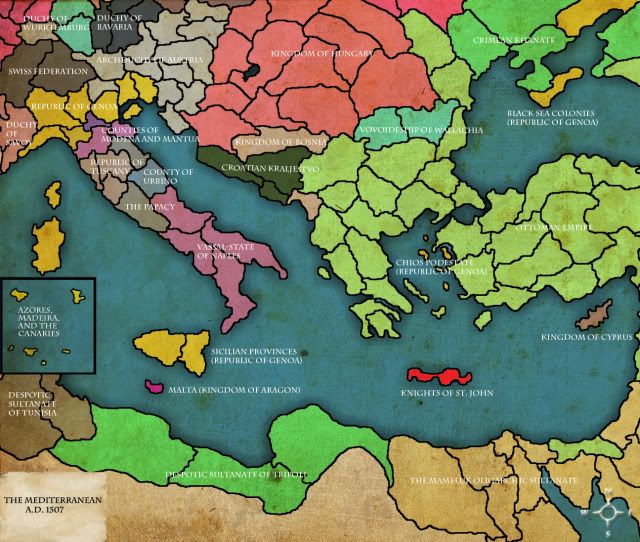

The powerful House of Valois


The powerful House of Valois
__________________________________________________
Last edited:
YOu got your revenge aginst Venice for being much more famous then Genoa! Looks like you have alot of terra fermma 
wolfcity Venice more famous than Genoa? Pfft, Genoa gave the world Christopher Columbus, Venetians gave the world... curtains
Best of luck in your Genoa game, hope you have as much fun as I do!
SplendidTuesday Haha, that does have quite a ring to it. Unfortunately, Columbus has left Genoa in the 1470s and has already made the historic voyage to the Americas.
Though I reckon there would be a "massive noble opposition" if a poor weaver's son ever got to be Doge in Genoa ;p yeah yeah, I know Republics can't have noble oppositions. Shame really
Derahan, mayorqw and TonyJoe Thanks for continuing to follow this AAR. It warms the cockles of my heart knowing that people read this
Vandervecken I would've had a totally nerdy moment if Charles VIII was actually King of France in this game. But alas, Henri II would have to do, though he's roughly 20 years too early and the Reformation hasn't even started yet.
Alliances are like flowing water with Genoa; if you can't beat em, join em!
Rabid Thanks for following! Unfortunately, Venice no longer has any island holdings as the map in my update shows (giving Crete to the Knights, wtf was the Doge thinking.)
But fortunately, no provinces in Venice are in HRE territory (unlike previous versions of MMP) so there's some easy gains in northern Italy.
Yeah, kick the Pope is always a fun pasttime - though the papacy in this game is quite liberal with the excommunication bulls.
aldriq Can't trust the landlubbing Neapolitans with serious galley warfare! But yeah, they certainly make land warfare easier on the Italian peninsula due to their 2 army NIs.
Behold, I have 1 light ship! But alas, I have nowhere to go with it. Terra Incognita all around :/
gabor War with France, guffaw. I'm not that crazy - if I joined that War I just know that the Ottomans would declare, followed by Austria .
.
No venetian province in the HRE for MMU, rejoice!
Best of luck in your Genoa game, hope you have as much fun as I do!
SplendidTuesday Haha, that does have quite a ring to it. Unfortunately, Columbus has left Genoa in the 1470s and has already made the historic voyage to the Americas.
Though I reckon there would be a "massive noble opposition" if a poor weaver's son ever got to be Doge in Genoa ;p yeah yeah, I know Republics can't have noble oppositions. Shame really
Derahan, mayorqw and TonyJoe Thanks for continuing to follow this AAR. It warms the cockles of my heart knowing that people read this
Vandervecken I would've had a totally nerdy moment if Charles VIII was actually King of France in this game. But alas, Henri II would have to do, though he's roughly 20 years too early and the Reformation hasn't even started yet.
Alliances are like flowing water with Genoa; if you can't beat em, join em!
Rabid Thanks for following! Unfortunately, Venice no longer has any island holdings as the map in my update shows (giving Crete to the Knights, wtf was the Doge thinking.)
But fortunately, no provinces in Venice are in HRE territory (unlike previous versions of MMP) so there's some easy gains in northern Italy.
Yeah, kick the Pope is always a fun pasttime - though the papacy in this game is quite liberal with the excommunication bulls.
aldriq Can't trust the landlubbing Neapolitans with serious galley warfare! But yeah, they certainly make land warfare easier on the Italian peninsula due to their 2 army NIs.
Behold, I have 1 light ship! But alas, I have nowhere to go with it. Terra Incognita all around :/
gabor War with France, guffaw. I'm not that crazy - if I joined that War I just know that the Ottomans would declare, followed by Austria
No venetian province in the HRE for MMU, rejoice!
No venetian province in the HRE for MMU, rejoice!
Well between that and that lucky annex vassal mission you're about 10 times closer to forming Italy than I would have expected at this point
Now there's just the pesky matter of getting a core on Rome, I'm sure you have your methods though
Let's hope Europe does not go apesh*t with the reformation. It would be bad for business.
The only bad part about being allied with france are the recurrent stab hits.
The only bad part about being allied with france are the recurrent stab hits.
Following your AAR with eyes wide open 
Milan seems quite weak in this version, almost to the point where they are a non-entity.
Milan seems quite weak in this version, almost to the point where they are a non-entity.
I learn more and more about MMU, some things I like: naval force limits for merchant republics, some not so much - Venice's land outside HRE makes it an obvious easy prey (as if AI Venice wasn't weak enough in MMP). Your expansion is truly amazing. Well done! I envy your skills.
From your maps I see that, sadly, Azov province is as big as it used to be in older versions of MMP, also Parma got back its port.
Did Brabant rebel against Burgundy? And Savoy grabbed Franche-Comte? Venice giving Crete, one of its richest provs, to KoSJ is annoying as hell. I think the whole KoSJ mechanism should be overhauled.
Where did you get a colonist to colonise The Canaries (I see they're Ligurian)? Are there any of your provs overseas? Pbly only the Azores, right?
Alliance with France was a very smart move, even if it involves stab hits from time to time. Hope le Blob will stand by you when you turn the aggressor. (They have a core on your Milan, don't they?). I can't see anything irritating about Portugal in your update and you could certainly do with one more ally, a one with strong navy.
Maps and visual aids are great!
From your maps I see that, sadly, Azov province is as big as it used to be in older versions of MMP, also Parma got back its port.
Did Brabant rebel against Burgundy? And Savoy grabbed Franche-Comte? Venice giving Crete, one of its richest provs, to KoSJ is annoying as hell. I think the whole KoSJ mechanism should be overhauled.
Where did you get a colonist to colonise The Canaries (I see they're Ligurian)? Are there any of your provs overseas? Pbly only the Azores, right?
Alliance with France was a very smart move, even if it involves stab hits from time to time. Hope le Blob will stand by you when you turn the aggressor. (They have a core on your Milan, don't they?). I can't see anything irritating about Portugal in your update and you could certainly do with one more ally, a one with strong navy.
Maps and visual aids are great!
From your maps I see that, sadly, Azov province is as big as it used to be in older versions of MMP, also Parma got back its port.
Venice giving Crete, one of its richest provs, to KoSJ is annoying as hell. I think the whole KoSJ mechanism should be overhauled.
1. The map he's using (I assume he's colouring it in manually) is outdated, those 2 province changes are still in.
2. Agree, this event chain is insane. Just because one country gave one tiny worthless island to the Knights at some time during history we have the Knights popping up in Crete, Sicily and even the Baleares! It should only happen in particularly poor provinces and never in those of the same culture group as the owner, that would fix 99% of the strange results I think.
Speaking of the Black Sea holdings, I hope you take the 2 adjoining provinces at some point, it looks so pretty on the map!
Ar7 Your comments on Venice's terra firma possessions have been the source of my inspiration for this update
Glad to hear I got to play a small part in this AAR
Great expansion in the last two updates, glad to see that the provinces are integrated peacefully and that the Genoese still hold all the power. Usually difficulties arise if a country's size swells so much
What an update! Very well written once again, how do you manage to write that much? I usually get tired after 6-700 words hehe 
__________________________________________________
Chapter VI. Eye of the Storm
1507-1516, the following recount
the years of quiet punctuated by
various foreign developments
__________________________________________________
Imperial relations
Chapter VI. Eye of the Storm
1507-1516, the following recount
the years of quiet punctuated by
various foreign developments
__________________________________________________
Imperial relations
Though diplomatic envoys were dispatched to every quarter of the Mediterranean, beseeching foreign courts to recognize the formal annexation of Milan, Genoa's protests were not heard. In 1509, the Holy Roman Emperor Maximillian II saw fit to impose sanctions on the Republic, isolating her from the trade routes into the Germanic region. After another six months of negotiations, a compromise was reached – Genoa would retain the region of Lombardia, allowing a contiguous land route to her possessions in former Venezia, but allow the independence of the House of Sforza in Parma.
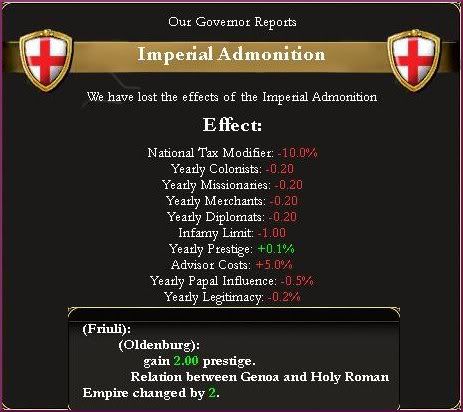
Genoa's yearly income slowly recovered after Imperial sanctions were lifted.

__________________________________________________
American ForaysAfter the success of the Genoese Columbus' forays into the West Indies, the Castillian crown commissioned a new expedition under Hernan Cortez to further chart the coast of the newly sighted landmass. After meeting with the Totanic chief Tentlil on Easter Sunday, the conquistador knew that somewhere in the interior there lies a city made of gold, ruled by a man named Montezuma.
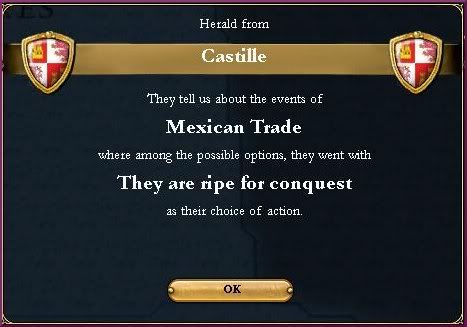
Although the land was hostile and the territory uncharted, they say Cortez proceeded with the determination of a man bent on a singular objective. The march into the Mexican interior, the entry into Tenochitlan in November, the taking of Montezuma into custody and the consequent “donation” of his empire to the crown of Castille – these are the events that represent the culmination of brilliantly executed military and political strategems that secured the annexation of the Yucatan to Castille.
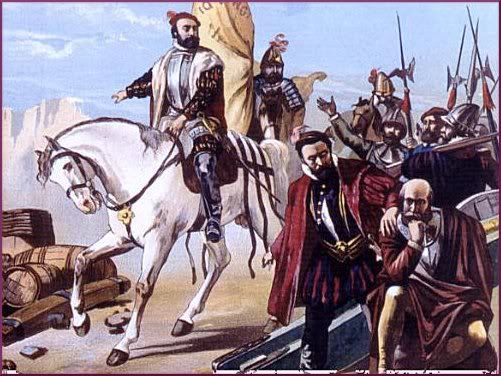
By the summer of 1512, it was widely acknowledged that the Castillians have discovered an entirely new world on the opposite side of India. New maps were drawn - a Florentine cartographer by the name of Amerigo Vespucci made one of the very first to enter widespread circulation in Italian courts.
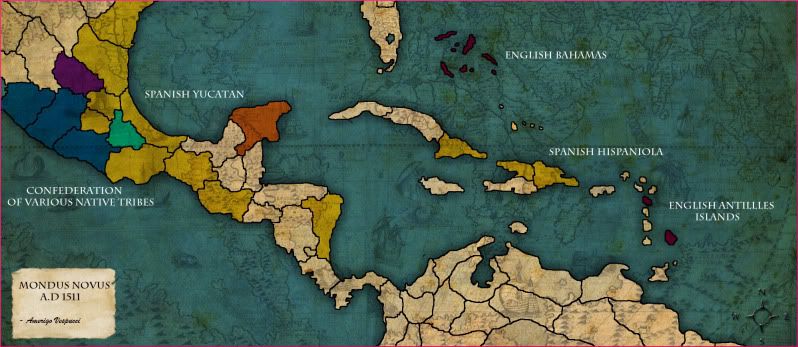
Tales of the cities of gold inspired ruffians and intrepid explorers alike to enlist under the Castillian expeditions, eager to acquire a share of the New World's wealth. Decades after the seizure of the Canary Islands from the Castillians, a skeleton infrastructure network of ports and docking stations were finally completed on the five main islands.
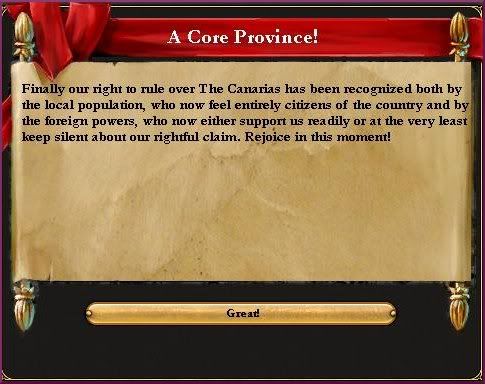
An expedition financed by the Genoese Republic, retracing the footsteps of the Cortez expeditions, is immediately commissioned (Golden Empires exploration route taken, though Castille has taken it first.

The need for such an expedition is more pressing than it may initially seem. The conquest of Goa by the Portuguese have confirmed an Eastward route to India and ships bound for the Calicut coast are leaving Lisboa with increasing frequency. The Ottomans are masters of the Eastern Mediterranean, the Castillians the curators of the New World, and the Portuguese sole proprietor of the route to India. Genoese fortunes were turning and trade volume through Liguria dwindling daily.
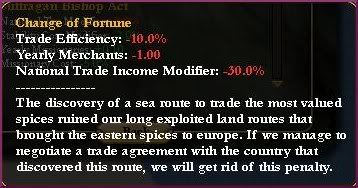
The continual antagonism between Lisbon and Liguria, begun over 50 years ago with the seizure of Madeira and the Azores from the Portuguese, have continued to this day. Today, nary a single pepper seed passes through the ports of Genoa. Times were changing – and Genoa needed to change with it in order to survive.

__________________________________________________
Berber PiratesSince the building of the first navigable ships, piracy has existed in the Mediterranean. Since the Medieval period, Christians and Muslims alike preyed on each other and often themselves. To the Ottomans, the Knights of St. John on Crete are nothing but rampant privateers. But in the beginning of the sixteenth century, this mutual harassment took on an entirely new dimension: the Barbary Coast became the breeding ground for a new kind of piracy.
Between Tangier and Tunis there was a 1,200 mile coastline, consisting of numberless natural harbors ideal for concealment and escape. The legend of the Barbary Coast was born here. In 1506, two brothers, Oruc Reis and Hizir-ed-Dein, started a daring war of terror and harrassment against shipping through the Mediterranean. Better known as Barbarossa, Hizir and his brother were born on the island of Mytilene, sons of a retired janissary who returned to Lesbos after years of service with the Ottomans.

During the summer of 1508, Hizir rallied a fleet of sixteen galleots and an army of 2,000 men. With this he marched along the coast of Tangiers, and landed off the main island of the Canaries. At once a heavy bombardment was commenced on the island fortress. But the Canaries islands itself was not their prize – the islands serve as a perfect ambush point for the Berbers to lie in wait for the Castillian galleons returning from the Caribbean to Cadiz. It was not only Spanish treasure they were looking for; every bit as profitable were the Christian prisoners aboard those ships.
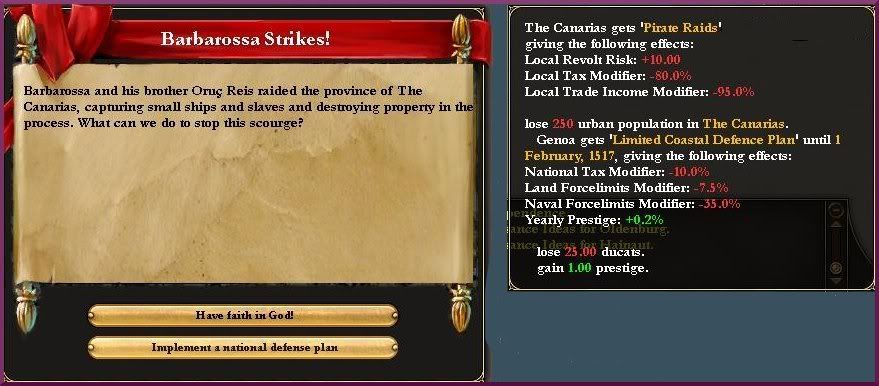
The Republic, already stretched thin by the need to guard her far flung possessions in the Atlantic and the Black Sea, saw fit to reach an agreement with Barbarossa. Henceforth, Barbarossa and the various Moroccan and Tunisian irregulars under his command would be allowed to set up a base of operations in one of the uninhabited islands off the Canaries. The agreement was of mutual benefit – Barbarossa would have a strategic base of operations against the Castillian Galleons and Genoa would secretly wage a war of attrition against her Iberian enemy.
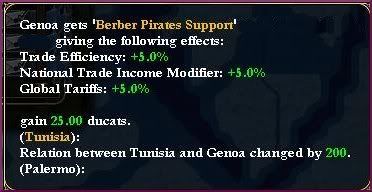
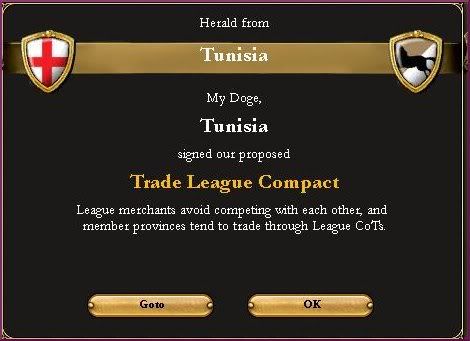
The results were alarming. In March 1510, a fleet of eight large Castillian galleons, was intercepted by the Berber galleots under Barbarossa. The Spanish ships were returning from Bologna, where the new Castillian King Ferdinand V had attended the ceremony of his coronation by Pope Leo X. The Berbers swung out and attacked the unsuspecting ships. In the hand-to-hand combat that followed, Ferdinand V's nephew Portundo of Aragon was killed. By the time the engagement was over, six of the galleons were captured, while two bearing the Castillian King and the various papal dignitaries escaped. Barbarossa and his galleots took refuge in nearby Genoa-controlled Sardinia, where the loot was divided and the damaged galleons repaired. The six great prizes – fully operational Spanish galleons, were gifted to Genoa as a sign of good faith by the Berbers, while the pirates retained the ducats from the princely ransom of the distinguished guests aboard the Castillian ships.

The Pope and Ferdinand V were understandably outraged. With discovery of Genoa's involvement in the sponsorship of the Barbary raids, in a papal bull on Easter Sunday in 1510, the Republic of Genoa was placed under interdiction for aiding the heathens in attacking Christian shipping.

Relations with the Mediterranean states (All of Italy, Aragon, Castille, Portugal), long quiet sufferers of the Berber terror, plummeted. Diplomatically isolated, spiritually condemned, and shamed beyond redemption, Genoa was alone. Seizing the opportunity, the Sultan declares war.


Genoa's yearly income slowly recovered after Imperial sanctions were lifted.

__________________________________________________
American Forays

Although the land was hostile and the territory uncharted, they say Cortez proceeded with the determination of a man bent on a singular objective. The march into the Mexican interior, the entry into Tenochitlan in November, the taking of Montezuma into custody and the consequent “donation” of his empire to the crown of Castille – these are the events that represent the culmination of brilliantly executed military and political strategems that secured the annexation of the Yucatan to Castille.

By the summer of 1512, it was widely acknowledged that the Castillians have discovered an entirely new world on the opposite side of India. New maps were drawn - a Florentine cartographer by the name of Amerigo Vespucci made one of the very first to enter widespread circulation in Italian courts.

Tales of the cities of gold inspired ruffians and intrepid explorers alike to enlist under the Castillian expeditions, eager to acquire a share of the New World's wealth. Decades after the seizure of the Canary Islands from the Castillians, a skeleton infrastructure network of ports and docking stations were finally completed on the five main islands.

An expedition financed by the Genoese Republic, retracing the footsteps of the Cortez expeditions, is immediately commissioned (Golden Empires exploration route taken, though Castille has taken it first.

The need for such an expedition is more pressing than it may initially seem. The conquest of Goa by the Portuguese have confirmed an Eastward route to India and ships bound for the Calicut coast are leaving Lisboa with increasing frequency. The Ottomans are masters of the Eastern Mediterranean, the Castillians the curators of the New World, and the Portuguese sole proprietor of the route to India. Genoese fortunes were turning and trade volume through Liguria dwindling daily.

The continual antagonism between Lisbon and Liguria, begun over 50 years ago with the seizure of Madeira and the Azores from the Portuguese, have continued to this day. Today, nary a single pepper seed passes through the ports of Genoa. Times were changing – and Genoa needed to change with it in order to survive.

__________________________________________________
Berber Pirates
Between Tangier and Tunis there was a 1,200 mile coastline, consisting of numberless natural harbors ideal for concealment and escape. The legend of the Barbary Coast was born here. In 1506, two brothers, Oruc Reis and Hizir-ed-Dein, started a daring war of terror and harrassment against shipping through the Mediterranean. Better known as Barbarossa, Hizir and his brother were born on the island of Mytilene, sons of a retired janissary who returned to Lesbos after years of service with the Ottomans.

During the summer of 1508, Hizir rallied a fleet of sixteen galleots and an army of 2,000 men. With this he marched along the coast of Tangiers, and landed off the main island of the Canaries. At once a heavy bombardment was commenced on the island fortress. But the Canaries islands itself was not their prize – the islands serve as a perfect ambush point for the Berbers to lie in wait for the Castillian galleons returning from the Caribbean to Cadiz. It was not only Spanish treasure they were looking for; every bit as profitable were the Christian prisoners aboard those ships.

The Republic, already stretched thin by the need to guard her far flung possessions in the Atlantic and the Black Sea, saw fit to reach an agreement with Barbarossa. Henceforth, Barbarossa and the various Moroccan and Tunisian irregulars under his command would be allowed to set up a base of operations in one of the uninhabited islands off the Canaries. The agreement was of mutual benefit – Barbarossa would have a strategic base of operations against the Castillian Galleons and Genoa would secretly wage a war of attrition against her Iberian enemy.


The results were alarming. In March 1510, a fleet of eight large Castillian galleons, was intercepted by the Berber galleots under Barbarossa. The Spanish ships were returning from Bologna, where the new Castillian King Ferdinand V had attended the ceremony of his coronation by Pope Leo X. The Berbers swung out and attacked the unsuspecting ships. In the hand-to-hand combat that followed, Ferdinand V's nephew Portundo of Aragon was killed. By the time the engagement was over, six of the galleons were captured, while two bearing the Castillian King and the various papal dignitaries escaped. Barbarossa and his galleots took refuge in nearby Genoa-controlled Sardinia, where the loot was divided and the damaged galleons repaired. The six great prizes – fully operational Spanish galleons, were gifted to Genoa as a sign of good faith by the Berbers, while the pirates retained the ducats from the princely ransom of the distinguished guests aboard the Castillian ships.

The Pope and Ferdinand V were understandably outraged. With discovery of Genoa's involvement in the sponsorship of the Barbary raids, in a papal bull on Easter Sunday in 1510, the Republic of Genoa was placed under interdiction for aiding the heathens in attacking Christian shipping.

Relations with the Mediterranean states (All of Italy, Aragon, Castille, Portugal), long quiet sufferers of the Berber terror, plummeted. Diplomatically isolated, spiritually condemned, and shamed beyond redemption, Genoa was alone. Seizing the opportunity, the Sultan declares war.

__________________________________________________
Last edited:
Iwanow Just when you think you're close to achieving your goals, MMP throws a sh*tstorm at you ;p
mayorqw The reformation is going to be particularly interesting this time from what I've seen. And yeah, business is going to suffer
Suffering stab hits with France assumes that France will actually care enough to keep our alliance!
Zolotaya Thanks for following! The Italian states have always been problematic. In previous versions of MMP it was Savoy and the Papal States with the constant suicidal DoWs on Urbino. Now it's usually Milan who does the self-destructive actions. Really, they bring shame on the House of Sforza for the utter lack of foresight in their diplomacy.
gabor
Thanks for the kind words Yeah, I'm using an old blank IN map and photoshopping/coloring it in. The old map is out of date - in MMU azow is much smaller and parma does not have a port. My American education precluded me from even noticing that irregularity of European geography!
Yeah, I'm using an old blank IN map and photoshopping/coloring it in. The old map is out of date - in MMU azow is much smaller and parma does not have a port. My American education precluded me from even noticing that irregularity of European geography!
Austria forced Burgundy to release a bunch of minors (Brabant, Hainaut, Friesland etc) and Savoy managed to seize Franche-Comte in the process. At one point the whole of Northern Europe was DoWing poor Burgundy.
Yeah, before the Knights got Crete, I got a bunch of requests for them to have Messina/Palermo. Like hell ;p.
Earlier in the second update I mentioned that I took Colonial Ventures as my gov tech 12 NI (there was no picture though, sorry about that). Also, Genoa is one of the few medium powers (along with Netherlands) that gets the "colonial vision" modifier for +0.2 colonists a year by default after Columbus' voyage.
I restricted the Canaries growth to ~900 pop of Castillians until I had the colonist to insta-transform it to a Ligurian city.
None of my provinces are overseas, the Azores is still considered "European."
I mentioned why Portugal is irritating in this update - discovery of spice route means that I suffer a permanent malus to trade. Portugal will also NEVER join my trade league because it is a) a major power and b) has a CoT. The only way to get rid of the modifier is by enforcing it through a truce, but Portugal will break it the moment truce expires.
Now my relations with Portugal/Castille/Aragon are at a solid -200 ;p.
Rabid yeah, sorry about the map, didn't notice the details ;p
Kouban and Crimea, the two provinces adjoning Kaffa & Azow, are both tribal + nomadic and kouban is tax 2 and produces wool. I think the only province worth taking in Crimea is the province of Jedysan - produces hemp, is ukrainian orthodox, and has basetax of 8-9.
thebigboss Heh, when you're a college student procrastinating on writing his 80 page dissertation, 2-3 pages of an AAR seems a breeze.
Ar7 & Davisx3m & Dinofs Thanks for continuing to follow this
mayorqw The reformation is going to be particularly interesting this time from what I've seen. And yeah, business is going to suffer
Suffering stab hits with France assumes that France will actually care enough to keep our alliance!
Zolotaya Thanks for following! The Italian states have always been problematic. In previous versions of MMP it was Savoy and the Papal States with the constant suicidal DoWs on Urbino. Now it's usually Milan who does the self-destructive actions. Really, they bring shame on the House of Sforza for the utter lack of foresight in their diplomacy.
gabor
Thanks for the kind words
Austria forced Burgundy to release a bunch of minors (Brabant, Hainaut, Friesland etc) and Savoy managed to seize Franche-Comte in the process. At one point the whole of Northern Europe was DoWing poor Burgundy.
Yeah, before the Knights got Crete, I got a bunch of requests for them to have Messina/Palermo. Like hell ;p.
Earlier in the second update I mentioned that I took Colonial Ventures as my gov tech 12 NI (there was no picture though, sorry about that). Also, Genoa is one of the few medium powers (along with Netherlands) that gets the "colonial vision" modifier for +0.2 colonists a year by default after Columbus' voyage.
I restricted the Canaries growth to ~900 pop of Castillians until I had the colonist to insta-transform it to a Ligurian city.
None of my provinces are overseas, the Azores is still considered "European."
I mentioned why Portugal is irritating in this update - discovery of spice route means that I suffer a permanent malus to trade. Portugal will also NEVER join my trade league because it is a) a major power and b) has a CoT. The only way to get rid of the modifier is by enforcing it through a truce, but Portugal will break it the moment truce expires.
Now my relations with Portugal/Castille/Aragon are at a solid -200 ;p.
Rabid yeah, sorry about the map, didn't notice the details ;p
Kouban and Crimea, the two provinces adjoning Kaffa & Azow, are both tribal + nomadic and kouban is tax 2 and produces wool. I think the only province worth taking in Crimea is the province of Jedysan - produces hemp, is ukrainian orthodox, and has basetax of 8-9.
thebigboss Heh, when you're a college student procrastinating on writing his 80 page dissertation, 2-3 pages of an AAR seems a breeze.
Ar7 & Davisx3m & Dinofs Thanks for continuing to follow this
Last edited:
Hard times. Perhaps they will turn out to be the best of times as well? Blockade the Grand Turk into submission.

